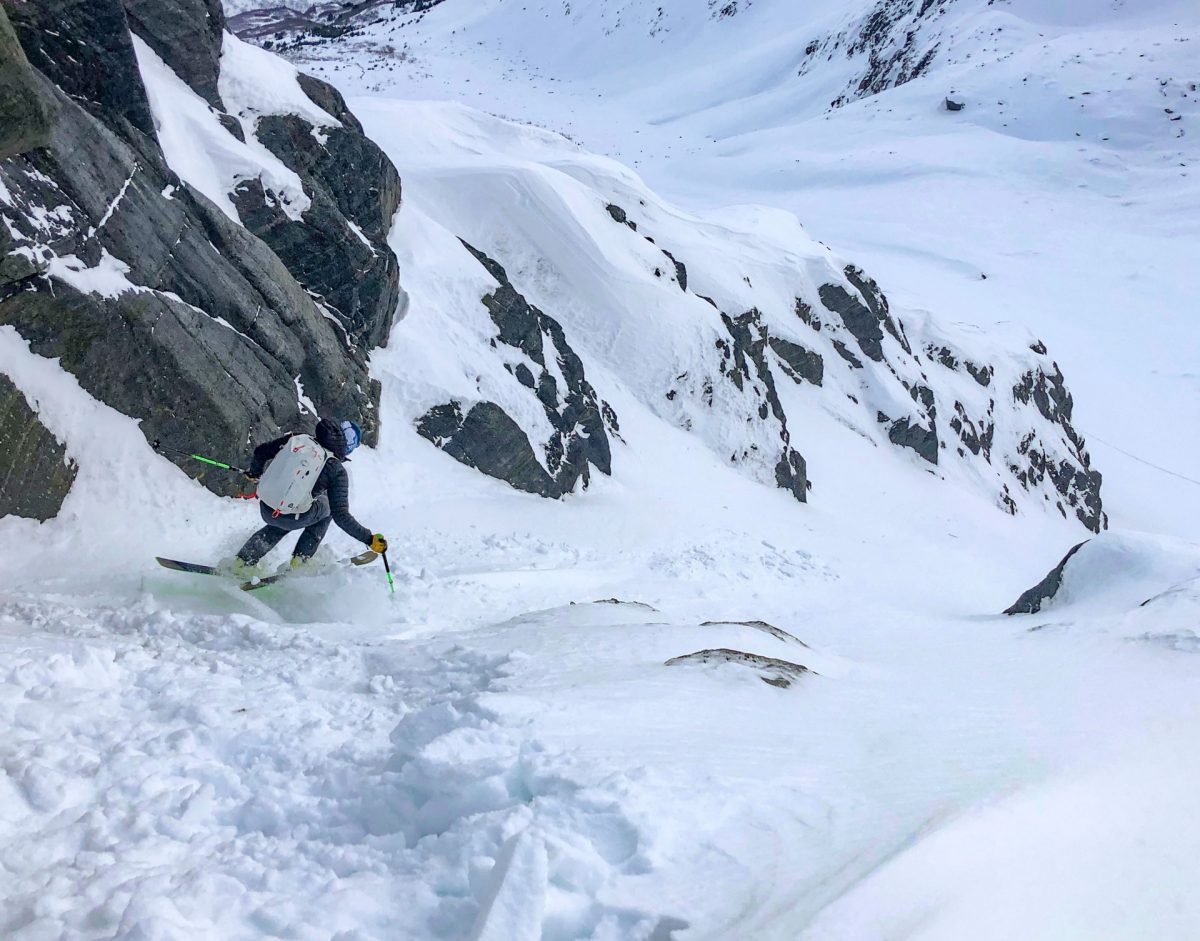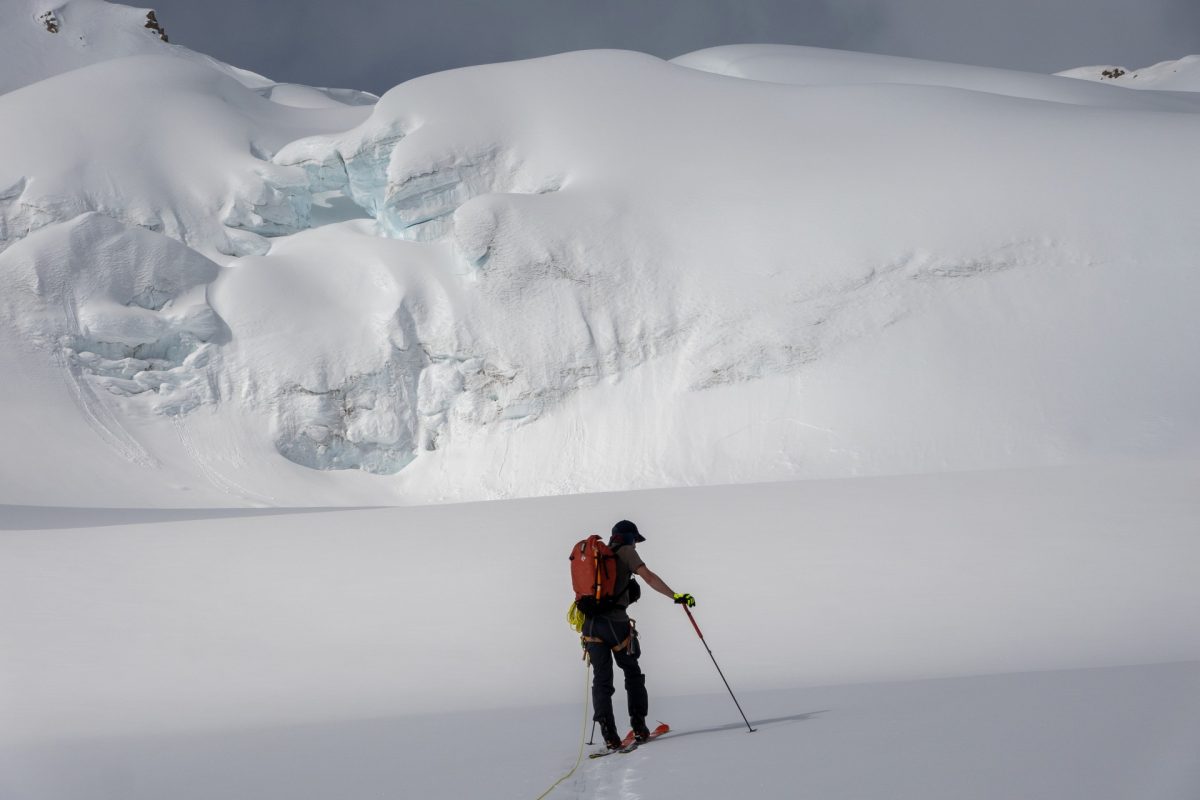
This image of the author on a recent gear testing jaunt was not posted on social media. But, in contrast, and with some irony, is being used for editorial purposes here with the permission of the photographer. Photo: Najeeby Quinn.
Thoughts on social media and the backcountry scene: Social media is entertainment, not connection. It can be great entertainment, whether a post is authentic or not. Social media is also an unnecessary, but powerful tool. No matter how you feel about it, that power is worth careful consideration.
Ya know how social media is ruining humanity by turning us into cogs in the commercialization machine, reducing our identity to data for sale, and draining our time into a black hole of meaningless content? Or, wait, is it a platform that makes us more connected and in the know than ever before #secretstash? Or maybe it’s a space for ‘creatives’ to guide us in #grateful revelation? Or just a way to catch a bit of footy for the boys…one, two, three dropping?
It seems to me like no one really likes social media these days, but it’s still at the height of social prominence – I dunno, maybe I’m just getting older.
Enter JOMO
A few years ago a friend introduced me to the term JOMO. Most will be familiar with FOMO, the fear of missing out—a phenomenon easily precipitated by thumb-scrolling social media consumption. JOMO is the joy of missing out—a subtle satisfaction at escaping the self-imposed dopamine race and neuro-vortex of engagement. Last year, I decided to embrace a bit of JOMO and I quit social media.
Plenty has already been said about the ups and downs of social media, and hating on false perceptions or the business that is social platforms is nothing new. Still, I promise I will be brief: Social media feeds on unhealthy comparisons, one-upmanship, and turns us into a commodity. I don’t like how social media turns a ski day into content and warps validation into a like button. This measurably increases anxiety, especially in young people. All of this has unique consequences in the backcountry community, where appearances and decision-making don’t always play well together.
When I was a more regular scroller, I got plenty out of social media, but I just didn’t like the forced comparisons pushed into my feeds–It’s just too easy to get caught worrying you didn’t ‘optimize’, even after a killer day out. It is, after all, always a pow day on Instagram. Or worse, to feel pressure to push things a little further if you get the impression others are doing the same. Now maybe going cold turkey is a bridge too far for most, but some deliberate thinking on how we post, scroll, consume, and feed social media can help anyone stave off the Fomo.
Just because I’m feeling down on social media, doesn’t mean there’s no place for feeds and likes in the ski community. I was, after all, a skeptical glutton for years, before pulling the plug. I love seeing what friends are up to, hearing stories of adventure from around the world, and enjoying photography from the mountains. Social media is a way to stay in touch with friends, find community, share information, and activate others around good causes. I mean, how else are we supposed to learn when another episode of the Fifty drops?
View this post on Instagram
Influencing the Scene
To keep myself honest, I decided to check in with an ‘influencer’ and get a more professional and measured take on the ups and downs of Instatweetbook. In the mountain community, few skiers have brought the backcountry into social media vogue, and fewer still have attained the influencer status, blue check mark, and all. Cody Townsend has amassed nearly 200,000 Instagram followers, otherwise known as every single backcountry skier. I figured this made Mr. 50 the guy to chat with about social media in the ski community.
Cody shares true stoke for the mountains, a positive attitude, an eye for safety, and a love for skiing in his posts, stories, and videos. “Of course I’m a negative influence,” he says, “I tell people skiing is awesome!” I am genuinely a fan. That said, Cody was upfront in our conversation about social media pressure in professional skiing and readily admits it’s a platform and a business–he doesn’t really like Instagram outside of professional responsibilities.
Cody was also quick to say that although his ski days are ‘content,’ a day of skiing gets to count as a work day. He also appreciates how social media puts the curation of what’s popular in the community’s hands.
“It gave me a lot more power,” Townsend says, talking about the change that came in professional skiing with Social Media’s rise. “There aren’t the same gatekeepers … I now get to tell the stories I want to tell and see if it works for my career.”
I appreciate Cody’s honest take on growth, mistakes, and the challenges of big-line skiing. Often, the internet seems to allow us to curate an idealized representation of ourselves, only to see an algorithm pressure us to erode our authenticity through self-aggrandizement and half-truths. The Fifty project, and Cody’s social media posts around it, stave this off by embracing the misadventures and turn-arounds.
“Skiing the line was [often] just the cherry on top … the Fifty gave me a platform to talk about how we make decisions… I didn’t plan the series to have an educational aspect, but I just found that stuff fascinating, to show how we make decisions, how we decide to bail, how we plan…waiting for weeks.”
I am not sure a project like the Fifty would really work without social media, and its a positive overlap of entertainment and a solid look at ski mountaineering.
Good storytelling and honest marketing can navigate the online landscape tactfully. However, a worry I am left with is that the business of social media and the network of social media don’t usually look any different—commercialization just isn’t explicit on Instagram or Facebook. This means that brands and influencers shape norms that filter into more personal social interaction. A funny consequence is that while most people aren’t getting paid to post on social media, everybody is advertising. Athletes like Cody feel the pressure of content creation; they push to be as authentic and down to earth as possible, while other friends in my feed often seem to present themselves as ‘branded’ because it’s where the norms of ‘cool’ sit online. Cody told me it’s a tricky balance, “because you’re communicating with your audience, but you also have to sell stuff or promote brands…”
So, Cody Townsend genuinely seems like he wants to be my friend, while many friends want to be Cody Townsend. Brands win twice.
Although I am in no hurry to jump back on board, after talking with Cody, I did find myself more optimistic about social media in the community after our conversation. He countered my unintentional Marxist inflammation with a measured look at each social platform as a tool.

The author wonders if this photo would do well on Insta? And for the discerning eye, there is some beta here. Photo: Alex Lee.
Can you get good beta on Instagram or Facebook?
“Yes and no,” he said. “If you spend enough time traveling around you can have an acute sense of if its as good as they say its good….avalanche conditions can be tough because you are relaying on an unreliable source. Individuals might be sharing things to hide mistakes or amplify how well they did….…[social media] is a helpful source, so long as you look at other sources as well.”
Cody also sees a huge positive in how safety information can spread. Backcountry skiing has exploded in the last few years, but avalanche fatalities have not. Townsend hypothesizes social media has positively contributed to this: young people are more connected than ever, so more informed than ever, because avalanche conditions and observations are thrust in your face. Also, the same peer pressure that can drive bad decision-making can also drive good decision-making: when everyone talks about how dangerous it is in the mountains, you don’t go.
Balancing the JOMO and FOMO
I am still worried that Instagram, in particular, convinces us to mediate experiences through cameras and captions. Cody pointed out that it can also get more people stoked on getting outside. I am worried that Facebook feeds bring out divisiveness and that the algorithms dangerously equate rad with reckless. Cody pointed out to me that anytime you don’t like what someone posts, you can of course unfollow them. Maybe there is just an inherent contradiction, since we can’t share, ‘hey enjoy the moment,’ without cutting into the moment?

Plenty of open space and quiet to contemplate the art and science of the FOMO to JOMO progression. Photo: Alex Lee.
Here’s where I’ve landed: social media is entertainment, not connection. It can be great entertainment, whether a post is authentic or not. Social media is also an unnecessary, but powerful tool. No matter how you feel about it, that power is worth careful consideration.
I have to ask my friends to text me photos, I take fewer pictures, and I ask more questions. I have found joy in missing out and a quiet comfort in keeping more of my experiences in the mountains for myself. Though, I do really miss Jerry of the Day.
My final thought: use social media if it makes you happy. Don’t use it if it doesn’t make you happy….either way, know you don’t need it, you can always find great stories and stoke scrolling the blogosphere instead. What do you think?
Dr. Alex Lee lives in Anchorage, Alaska. Alex is a professor at Alaska Pacific University, teaching philosophy and environmental studies. He also works as a sometimes guide, naturalist, writer, and photographer.
